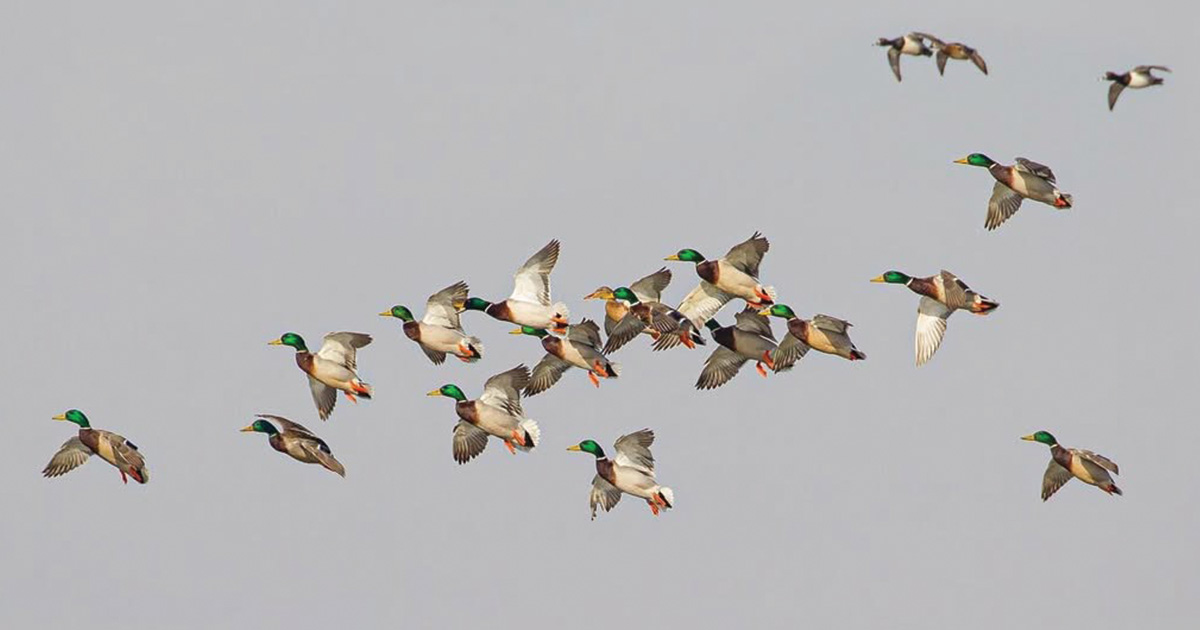Migration Alert: Illinois Hunters Dealing with Low Water Conditions, Duck Numbers Increasing
Nov. 24, 2025 – Mississippi Flyway – Illinois
Nov. 24, 2025 – Mississippi Flyway – Illinois

Illinois waterfowl hunters have been in a feast-or-famine situation, largely due to water levels in some key migration areas. Segments of the Great Lakes Region have been impacted by ongoing drought conditions the past few years, leaving Prairie State watersheds running at very low levels. This includes the waterfowl migration corridors, the Illinois and Mississippi Rivers.
“I think we've seen a few mallards trickle in, but a large portion of the ducks that arrived on the last front have grown stale, blind shy, and decoy shy,” says Austin Matheny, who spends nearly every day of the season in a blind in the Illinois River Valley. “We're having successful hunts with a mixture of mallards, ringnecks, and the occasional wigeon or teal, but there are a lot of hunters struggling right now because ducks just aren’t moving much due to the nice weather. If you're near a roost or a refuge, it seems those areas are doing fine. However, if you’re not, it’s causing struggles.”
The key difference between success and failure is the ability to manage water levels. Whether they are state, federal, or private tracts managed for waterfowl that have the capability to pump water or divert it, they are very likely holding excellent numbers of waterfowl. However, tracts planted with crops or left in moist soil along the river valleys that rely on natural flooding, are high and dry.
“The river is low. It has been low, but it’s low-low now,” reports guide and property manager Sean Herrick. “I mean the food on the banks is way far away from the river. If it’s not a refuge or somewhere with controlled water, there is no habitat value. None.”
Duck food availability will play a major role in how long ducks stick around in the Illinois and Mississippi River Valleys. Many species rely primarily on aquatic vegetation and invertebrates, and eventually resources run low. However, mallards are able to stick around long after other species have migrated further south. Besides being a hearty species, mallards habitually dry feed in picked corn fields. This allows them to ride out periods of inclement weather and remain in the area long after seasons have ended. While mallard numbers around Illinois are far from peak levels, once new mallards do arrive they will find plenty of harvested fields to work with, as Illinois’ corn harvest is nearly complete for the year.
While numerous species in the Illinois and Mississippi River Valleys are present in good numbers, mallards are still well below long-term averages (LTA) according to recent aerial surveys conducted by Forbes Biological Station in Havana. According to Wetland Bird Ecologist Josh Osborn, with the exception of mallards, puddle duck species were above the LTA across the board in the Illinois River Valley.
In sharp contrast, the same species were well below the LTA in the adjacent Mississippi River, with the exception being diving duck species, which are outstanding. “Other than redheads, scaup, and canvasbacks, all other species were also below LTA this week,” explained Osborn in his weekly blog. “Though the divers on Pool 19 aren’t necessarily early, I wasn’t expecting the number we saw. The rafts took a couple of extra passes to wrap my head around.”
Illinois Department of Natural Resources aerial surveys indicate decent numbers of birds present in many management areas, including those located in the southern third of the state. Southern Illinois was once known for outstanding Canada goose hunting, but honker numbers are paltry compared to the past. Over the past several decades, focus has shifted to snow and white-fronted geese, with both species slowly building in key areas around the state.
There is good news for Illinois hunters and Great Lakes Region hunters in general, as an impactful weather system will hit the Upper Plains and the Upper Great Lakes Region early this week, with accumulating snow from the Dakotas across northern Minnesota and Wisconsin into Michigan’s Upper Peninsula. While temperatures remain above freezing for the most part further south, this system is going to dial up impressive winds that will send ducks south into the interior of the Mississippi Flyway. If nothing else, mallards are a little overdue, and it sure will be nice to see some newcomers during the Thanksgiving holiday.
Stay up to date with the latest migration information.
Ducks Unlimited uses cookies to enhance your browsing experience, optimize site functionality, analyze traffic, and deliver personalized advertising through third parties. By continuing to use this site, you agree to our use of cookies. View Privacy Policy